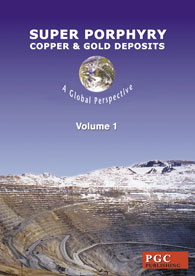

Kurt C. Friehauf - Dept. of Physical Sciences,
Kutztown
Univ., Kutztown, PA 19530
Stacie Gibbins - Dept.
of Geosciences, University of Arizona, Tucson, AZ 85721
Spencer Titley - Dept.
of Geosciences, University of Arizona, Tucson, AZ 85721
Friehauf, Kurt,
Gibbins, Stacie, and Titley, Spencer, 2005, Porphyry-Style
Mineralization in the Ertsberg Diorite, Gunung Bijih
(Ertsberg/Grasberg) District, West Papua, Indonesia: in Porter, T.M., ed., Super
Porphyry
Copper
& Gold Deposits - A Global Perspective, PGC
Publishing, Adelaide, Australia, v. 2, p. 357-366.
Abstract
Newly-recognised porphyry-style
mineralisation within the Ertsberg intrusion displays significant
differences from porphyry mineralisation at the Grasberg porphyry Cu-Au
deposit. Stockwork mineralisation in the Ertsberg occurs
near the giant East Ertsberg Skarn System close to the northern margin
of the intrusion. Stockwork mineralisation in the diorite
is spatially associated with 5 to 15 m wide east-striking dykes of
porphyritic hornblende monzonite that cut equigranular Ertsberg
diorite. The porphyry dykes strike parallel to major
district structures and occur where those structures project into the
Ertsberg intrusion. Hornblende abundance greater than
biotite, the much greater abundance of sphene, a paucity of broken
phenocrysts, and the aplitic groundmass distinguish the porphyry dykes
in the Ertsberg Stockwork Zone from the finer-grained groundmass Kali
dykes of the Grasberg deposit.
Hydrothermal alteration in the Ertsberg Stockwork Zone proceeded
through three main stages with little repetition: i) early
feldspar-stable alteration, ii) transitional stage characterised by
green sericite veins and endoskarn development, and iii) late stage
quartz-sericite-pyrite alteration. Feldspar-stable
mineralisation pre-dates the Ertsberg porphyry dykes, but
feldspar-destructive alteration post-dates the porphyry.
Although economically-important, early, hairline bornite veinlets and
zones of pervasive shreddy biotite alteration of hornblende cut
equigranular diorite and not adjacent porphyry, while garnet-bearing
endoskarn and sericitic alteration types both cut the porphyry dykes,
suggesting the dykes intruded during mineralisation.
Transitional stage bornite-chalcopyrite and chalcopyrite-pyrite bearing
green sericite veinlets which are important contributors to both copper
and gold grades, have magnetite-bearing halos where they cut endoskarn,
and quartz-green sericite selvages in diorite. Late-stage
veins contribute little to grade, contain quartz-sericite-pyrite
±
chalcopyrite filling and have white sericite selvages.
Compared with rocks from the nearby Grasberg deposit, the Ertsberg
porphyry mineralisation has a coarser grained groundmass in the
porphyritic phases, a much weaker development of hydrolytic alteration
styles, an absence of very high sulphidation state mineralisation /
advanced argillic alteration, and an absence of breccias in igneous
rocks, suggesting the physiochemical conditions of mineralisation for
the two deposits differed significantly.
The calcic nature of the endoskarn veins, their spatial relationship
with regional structures and the porphyry dykes, and their coincidence
with a change in mineralisation style from feldspar-stable to
feldspar-destructive hydrolytic assemblages suggests porphyry dyke and
endoskarn formation correspond to a major shift in mineralising
conditions in the Ertsberg Stockwork Zone.